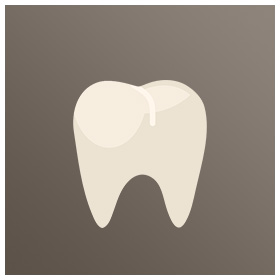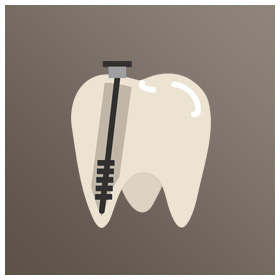Dental Implants
What are dental implants?
Dental Implants are fixtures made of titanium alloy or zirconia (ceramic) that are placed in the jaw replacing a missing tooth / teeth.
How do dental implants work?
Dental implants are integrated in our bone and provide a new “root”, a stable support, for a crown or bridge to be supported on it. Dentures can also be supported on implants so as to make them completely stable and functionable. In order to receive dental implants you must have a good oral and body health. Meticulous oral hygiene and regular dental visits are critical to the long-term success of dental implants.
Ceramic Metal-Free Implants
Ceramic implants offer a unique aesthetic solution for patients with specific needs. Some patients have a thin gingiva biotype, which requires a specific treatment approach, and others simply express their explicit wish for a metal-free alternative.
Ceramic implants are made of zirconia oxide providing the sole indication for a holistic and biological approach to dental Implantology and represent the only choice for a completely metal-free, biocompatible dental treatment. Zirconia implants are completely integrated to the jaw and are biologically the best option for our overall health.
Zirconia implants are pure white and give the best esthetic results. Bacterial plaque does not adhere to zirconia as it does on titanium implants thus reducing the risk of gum inflammation and peri-implantitis, which can lead to implant loss and even more serious conditions like diabetes and cardiovascular disease.
Implant Surgery
Implant placement is a simple process when the patient has adequate bone available. If not, bone grafting procedures and sinus lifts are performed to increase bone quantity and quality so as to provide implants to the patient. We use Advanced Platelet Rich Fibrin (APRF) for our grafting procedures, the most advanced biological process. The patient’s own blood is centrifuged and used, therefore yielding excellent results.
APRF is a new advanced technology that helps wounds heel faster anywhere in the body including those involved in oral surgery, using the patient’s own blood. Unlike Platelet Rich Plasma (PRP), it has no additives. In addition, APRF is very rich in platelets, growth factor cells (leukocyte cells) and contains enriching Fibrin, which is the key ingredient for initiating the healing of a wound with added antibacterial properties. It is also used for periodontal treatments and skin rejuvenation mesotherapies.
Preventive Dentistry – Dental Hygiene
A healthy mouth is of upmost importance for a healthy body. Maintaining an excellent oral hygiene and healthy teeth is our priority for our patients.
Preventive dentistry is the modern way of helping you keep a healthy mouth. It helps you keep your teeth, and in effect results in less dental treatment. The two main causes of tooth loss are decay and gum disease. The better you prevent or deal with these two problems, the more chance you will have of keeping your teeth for life.
When the patient and dental team work well together, they can help to prevent the need for treatments – especially fillings and extractions. Your dental team may recommend a course of treatment to get your mouth into good condition, and then work out a ‘maintenance plan’ to help you keep it that way.
Your overall health is our priority. We value and understand the importance of preventative dentistry in enabling you to achieve optimum health. As part of our preventative dental program, we regularly screen for oral cancer and other conditions. Eerly detection of soft tissue abnormalities, cancerous or pre-cancerous lesions, can be life saving. Oral ID is an innovative tool we use during our examinations. Oral ID uses fluorescence technology to aide in the visualization of oral cancer, pre-cancer and other abnormal lesions.
Oral Surgery / Tooth Extractions
We specialize in wisdom teeth removal, simple and surgical extractions, cyst removal and apicectomies.
The most recognized form of oral surgery is tooth extraction. Reasons for tooth extraction can include:
• Impacted or partially erupted wisdom teeth
• Teeth beyond repair either from tooth decay, root fracture, or trauma
• Primary teeth that have failed to fall out, preventing the eruption of permanent teeth
• Orthodontic treatment plans, which may require the removal of some teeth to reduce crowding and achieve the optimum result
• Teeth that have unrepairable mobility due to periodontitis
Prosthetic Dentistry
Prosthetic dental treatment refers to reconstruction of broken teeth or replacement of missing teeth and provides proper mastication and aesthetics. It can be achieved by providing crowns, bridges, dentures and implants. We practice metal-free dentistry and use high quality ceramics (zirconia) for reconstruction and replacement (with ceramic implants).
A dental prosthesis is an intraoral (inside the mouth) prosthesis used to restore (reconstruct) intraoral defects such as missing teeth, missing parts of teeth, and missing soft or hard structures of the jaw and palate. Prosthodontics is the dental specialty that focuses on dental prostheses. Such prostheses are used to rehabilitate mastication (chewing), improve aesthetics, and aid speech. A dental prosthesis may be held in place by connecting to teeth or dental implants, by sunction, or by being held passively by surrounding muscles. Like other types of prostheses, they can either be fixed permanently or removable; fixed prosthodontics and removable dentures are made in many variations.
Permanently fixed dental prostheses use dental adhesive or screws, to attach to teeth or dental implants. Removal prostheses may use friction against parallel hard surfaces and undercuts of adjacent teeth or dental implants, sunction using the mucous retention (with or without aid from denture adhesives), and by exploiting the surrounding muscles and anatomical contours of the jaw to passively hold in place.
Aesthetic Dentistry
Cosmetic or aesthetic dentistry generally refers to any dental work that improves the appearance (though not necessarily the function) of a person’s teeth, gums and/or bite. It primarily focuses on the improvement of dental aesthetics, in color, position, shape, size, alignment and overall smile appearance.
Ceramic facings and high quality composites are used to provide excellent results. Teeth bleaching is an excellent method for improving aesthetics.
Endodontics
Root canal treatments are performed by our specialist in our clinic. Root canal treatment is an often straightforward procedure to relieve dental pain and save your teeth. Patients typically need a root canal when there is inflammation or infection in the roots of a tooth. During root canal treatment, the dentist carefully removes the pulp inside the tooth, cleans, disinfects and shapes the root canals, and places a filling to seal the space.
Endodontic treatment is necessary when the pulp, the soft tissue inside the root canal, becomes inflamed or infected. The inflammation or infection can have a variety of causes: deep decay from repeated dental procedures on the tooth or a crack or chip of the tooth. In addition, an injury to a tooth may cause pulp damage even if the tooth has no visible chips or cracks. If pulp inflammation or infection is left untreated, it can cause pain or lead to an abscess.
Soft Tissue Laser Therapy
With the advent of the Nd:YAG fiber optical systems, laser technology is becoming widely available for soft tissue management programs within the general practice setting. During laser therapy, laser light is applied to the affected area. The laser is precisely calibrated to deliver light in a therapeutic dose, wavelength, pulse, and duration.
Laser energy increases circulation, drawing water, oxygen, and nutrients to the damaged area. This creates an optimal healing environment that reduces inflammation, muscle spasms, stiffness, and pain. As the injured area returns to normal, function is restored and pain is relieved.
Digital Intra-Oral & Panoramic Radiography
Digital intra-oral and panoramic dental x-ray use a very small dose of ionizing radiation in order to protect our patients and staff.







